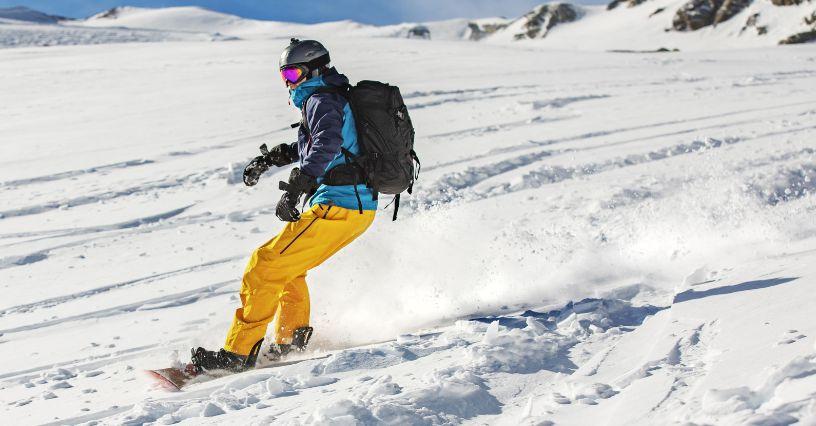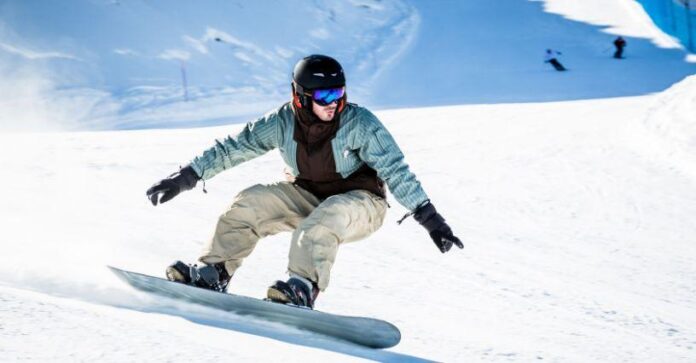Snowboarding is not only a great way to be active in winter with a good dose of adrenaline and excitement, but also the need to cope with changing weather conditions.
The right snowboarding clothing is the key to comfort, safety and full enjoyment. If you are wondering how to dress for snowboarding, to fully enjoy every moment on the snow, ensure maximum comfort, protection and also look stylish, you will find the answer in the following article.
Snowboard clothing – the most important functions
The right snowboard clothing is the key to snowboarding success, whether you’re a beginner snowboarder or an experienced freerider. But what exactly is the right clothing for this winter sport? Here are the main features to look out for when choosing snowboard clothing:
- weather resistance – Mountain weather can be fickle, so it’s important that your snowboarding clothing is waterproof and windproof. Snowboard jackets and pants with a membrane (eg GORE-TEX®) and a DWR (Durable Water Repellence) layer are ideal for maximum protection against rain, snow and wind;
- breathability – snowboarding can cause excessive sweating, so it pays to choose clothes with breathable properties. This will allow the water vapor to escape effectively. This way, you’ll avoid overheating, keep your skin dry and stay comfortable even when you’re pedaling really hard. High-quality materials in snowboarding clothing are designed to be waterproof and breathable at the same time;
- thermal insulation – Low temperatures and wind on the slopes can increase the feeling of cold, so it pays to pay attention to clothes with adequate thermal insulation. You can choose from different types of insulation, such as natural down, synthetic down (for example PrimaLoft®), fleece or technical heat-insulating materials;
- right size and fit – Snowboard jackets and pants should have a right fit to guarantee freedom of movement. At the same time, make sure they fit correctly in terms of size – not too tight (will restrict movement and cause discomfort or irritation), not too loose or too long;
- elasticity – snowboard clothing should be flexible, especially in key areas of movement such as elbows, shoulders, knees and hips. This allows you to maneuver freely on the slopes;
- ventilation – some snowboard clothing has ventilation systems that allow you to regulate your body temperature while riding, depending on the weather conditions or the intensity of the exercise. These are usually zippered vents located in sensitive areas (for example, in jackets, in the armpit area, and in pants, in the thigh and knee area);
- reinforcements – reinforced elements on the buttocks, legs or elbows help to extend the life of the garment and protect it from damage when it comes into contact with the slope or the edges of the board;
- practical pockets – depending on your needs, look for snowboard clothes with functional pockets for small items such as your ski pass, glasses, keys or snacks;
- adjustable hood – will protect you from snow, rain and wind. It is important that it is compatible with a snowboard helmet;
- adjustable cuffs or pants – this will allow you to customize your outfit and prevent snow from getting under your clothes;
- reflective elements – increase visibility, which is especially important when driving in difficult weather conditions, in conditions of reduced visibility or at night;
- comfortable zippers and fasteners – opt for garments with high-quality waterproof zippers and fasteners that are easy to handle even with snowboard gloves.

How to dress for snowboarding? The 3 layer rule
Dressing for snowboarding according to the three-layer principle is essential, as it allows you to adapt your outfit to changing weather conditions and the intensity of your activity on the slopes. The so-called onion outfit includes: the base layer (thermo-active), the insulating layer (e.g. fleece) and the outer layer (jacket and snowboard pants) . You can adjust the number of layers depending on the temperature and the intensity of your walk. On warmer days you can wear just a base layer and an outer layer, while in colder conditions you can add an insulating layer for extra warmth.
The base layer
The base layer is the first layer worn directly on the body. It is responsible for keeping you warm and wicking away moisture. When choosing thermal underwear, opt for thermo-active materials such as polyester or merino wool, which offer excellent insulation and breathability. The base layer should fit your body without being too loose or too tight. Avoid cotton, as it retains moisture and dries hard, which can lead to hypothermia (details in the article on cooling the body).
The intermediate layer
The insulation layer is a second layer of onion clothing designed to keep you warm. It is used in colder conditions to ensure optimal body temperature and avoid chilling. The intermediate layer must be light and provide adequate thermal insulation depending on the temperature on the slopes. An intermediate layer can be a fleece or a snowboard jacket with an extended back, or a light softshell jacket in cold weather .
Outer layer (jacket and pants)
The outer layer is the last line of defense against the elements. The jacket and snowboard pants must be waterproof and windproof to provide maximum protection against snow, rain and wind. At the same time, attention should be paid to breathability and ventilation systems that will reduce the risk of overheating and keep your skin dry. The minimum values for snowboard clothing in terms of waterproofness are 10,000 mm and breathability is 5,000 g/m2/24 h. A snowboard jacket and pants should be properly cut to allow freedom of movement during snowboarding and adjustable features such as cuffs, hood and legs for an optimal fit. In addition, a snow apron is useful with a snowboard jacket and – snow cuffs with pants to prevent snow or water from getting under your clothes.

Essential accessories for your snowboard outfit
To make your snowboarding outfit complete, you need to complement it with accessories that will ensure maximum comfort and safety while on or off the slopes. Here are some of them:
- snowboard boots – is essential to ensure stability and control of the board. Make sure the shoes fit well not only in terms of size, but also in terms of flex (stiffness), which depends on your walking style and level. Read the guide: How to choose snowboard boots?
- snowboard helmet – it is one of the most important pieces of protection – it protects the head from injuries in case of a fall or a collision with other users on the slopes. Make sure the helmet fits your head correctly and complies with safety standards (including: CE EN 1077 certification). Read more in our guide: How to fit a ski/snowboard helmet?
- goggles – good quality goggles protect your eyes from the sun, snow, wind and cold. Choose a model with a UV filter and suitable lenses to provide a clear view in different weather conditions. Pay attention not only to the color of the lenses, but also to their shape (spherical or cylindrical). Practical advice in the article: What ski goggles?
- hat/multifunctional scarf/bonnet/collar – maintain the correct temperature in the head and neck area to prevent heat loss and wind chill;
- gloves or mittens – they are essential accessories to protect your hands from cold and moisture. Choose models that are waterproof (for example, with a GORE-TEX® membrane) and that insulate well against heat. Read: Ski gloves .
- ski/snowboard socks – designed specifically for use on the slopes. They provide adequate insulation, remove moisture and protect against irritation and abrasion. More on their topic: What ski socks?
- knee and wrist protectors – if you are a beginner snowboarder or go on more difficult slopes, you should consider wearing knee pads and wrist protectors, as well as a so-called back protector. These accessories can help you avoid injury in the event of falls;
- ski backpack – provides a convenient way to carry essentials such as food, drinks, extra clothing or tools for adjusting bindings on the board. Make sure the backpack has a mounting system for the board so you can easily carry it when you take it out. Details: What ski backpack?



